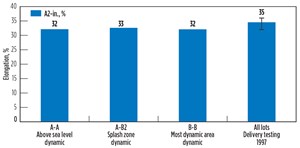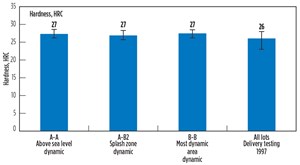Stainless steel umbilical tubing proves strength after 17 years’ subsea service
In 1998, one of the world’s first dynamic umbilicals was designed and installed in a deepwater oil and gas field, offshore Europe. The job required robust, reliable and long-lasting tubing for the dynamic umbilical. Sandvik was commissioned to provide an effective and risk-free solution.
Seventeen years later, the decision was taken to replace the incident-free umbilical as part of a routine inspection, repair and maintenance program for the field, and sections of the tubing were returned to the company for its own integrity testing. The results of those tests provided an extremely interesting insight into the alloy’s durability in subsea conditions.
After conducting a thorough investigation of its tubing deployed in the dynamic umbilical, it was determined that the Sandvik SAF 2507 tubes could have withstood at least 17 more years of service, as a solution to steel tubing in umbilicals.
CORROSION RESISTANCE ISSUES IN SALTWATER
The field is approximately 200 km offshore, in water depths ranging from 240 to 310 m. The umbilical was designed with a standard pressure rating of 10,000 psi, and a requirement for stainless steel tubing with a 0.5-in. internal diameter (ID) and a 15.7-mm outside diameter (OD), with a 1.5-mm wall thickness, to be used for hydraulic tubing and service lines. The enhanced strength and integrity of stainless steel were preferred over the thermoplastic hose for the tubing, in what was, at that time, still a comparatively novel umbilical design—as the industry looked to extend its activities into ever-deeper waters with longer step-outs.
In response to the requirements, the company’s metallurgists recommended the use of the super-duplex Sandvik SAF 2507 (UNS S32750) as an effective, fail-safe solution to potential strength and corrosion resistance issues for tubing in saltwater. In 1998, the company began producing this tubing at its facilities in Arnprior, Canada, for welding by the client at its own site, and ultimately, offshore deployment two years later.
The tubing has a super-duplex (austenitic-ferritic), stainless steel design that combines high corrosion resistance with high mechanical strength. With excellent resistance to seawater and marine environments, it is particularly well-suited for applications exposed to high stress in aggressive chloride-rich environments. Seamless tube and pipe in the tubing is supplied in dimensions with a maximum 260-mm OD. The steel grade is characterized by:
- Resistance to stress corrosion cracking (SCC) in chloride-bearing environments.
- Resistance to pitting and crevice corrosion.
- Resistance to general corrosion.
- Mechanical strength.
- Physical properties that offer design advantages.
- Resistance to erosion, corrosion, and corrosion fatigue.
- Weldability.
SEVENTEEN YEARS LATER
Earlier this year, after 17 years in service, the dynamic umbilical was retrieved during the installation of a replacement, and Sandvik was commissioned to review the performance of the stainless steel tubes. The tubes were first visually examined for any presence of corrosion or material degradation, and subsequently examined in the company’s laboratories.
Samples of the 0.5-in. ID and 15.7×1.5-mm OD stainless steel tubing were taken from a range of different points on the umbilical—including above sea level; the splash zone; the most dynamic section; the static section; and samples that had been in contact with the umbilical termination head (UTH). The stainless steel tubes were separated from the umbilical and sent to the company in 5-m lengths. The mechanical properties of the tubes were investigated and compared with the production data for the tubes prior to installation and against modern tubing tests. The high-cycle fatigue life of the tubes from the static, as well as the most dynamic section of the umbilical, were also investigated using four-point bend testing, and compared to reference data.
A range of issues could have been expected for the umbilical and tubing during such a considerable period of continuous deployment in hostile subsea conditions. Corrosion on the parent tubing, or in the welds, could have been one of the factors that might have occurred, particularly in the splash zone, which is subject to the rigours of continuous new water exposure. Similarly, hydrogen-induced stress cracking caused by a potential build-up of hydrogen on the approach to the UTH, under cathodic protection, is another issue that could have been experienced. Likewise, sections of the dynamic umbilical’s “S” curve could have suffered dynamic fatigue failure, especially in the welds, as a result of water current or wave stress.
TEST RESULTS
Tests were undertaken on straight or straightened sections of the 0.5-in ID and 15.7x1.5-mm OD tube, and on the welds. The investigations performed by Sandvik included:
- Visual examination,
- Chemical analysis,
- Surface analysis,
- Scale electron microscope (SEM) investigation,
- Delivery testing,
- Hydrogen content analysis, and
- Fatigue testing.
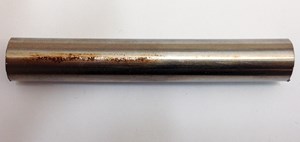
The results of the visual examination did indicate some occasional light discoloration of the tubing deployed in the splash zone, where a thin biofilm of salt and sediment had occurred. The organic matter was identified as approximately 0.1 –1.5-micrometers (µm) in thickness, and was investigated using a glow discharge, optical emission spectroscopy electron scanning microscope. It was found to be entirely consistent with the conditions experienced by the tubing in this section of the umbilical. This discoloration was quickly, and easily removed, by the application of soap and water, Fig. 1.
Varying degrees of scratching and contact points were also identified on the tubing during the visual examination. These scratches were found to be shallow and mostly longitudinal in direction. They were determined to have originated during the retrieval, dismantling and dissection of the umbilical, and the removal of the tubing for testing. Welds above sea level and in the dynamic section also were observed to be free from corrosion or fatigue.
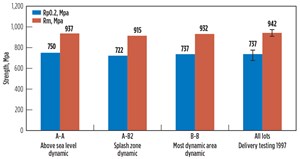
The overall visual appearance of the tubing sections showed no signs of damage, and although longitudinal scratches could be observed on almost all of the tested sections, these were found to be entirely superficial, and were deemed not to have affected the integrity of the tubing. In fact, despite having been in the sea for 17 years, Sandvik’s ink marking with a heat number was still clearly visible on the tubes, meaning they could be traced back to the original stock records.
No corrosion was observed on the outsides of the tubes, and although brown discoloration was identified on some surfaces, this was found to be sediment or salt-based and organic. It was agreed, therefore, that it was unlikely the tubes had been in contact with seawater during their deployment offshore, and they displayed no signs of punching holes. The insides of the tubes suggested some degree of residue in working media, such as ethanol, monoethylene glycol, or hydraulic fluid. However, the temperature of the fluids in the tubing was found to be consistent with those at the platform, and in an ambient state.
The mechanical properties of the tubes also were tested, with samples taken from tubes from 1998 and compared to those of 19 years later. No significant differences could be identified in yield, tensile strength or elongation (elongation tests require a minimum level of 25%) between the samples from 1998 and 2017, Figs. 2, 3 and 4. The burst pressure for the 19-year-old stainless steel tubing also was identified as being well above 25,000 psi, and more than twice the required design pressure, Fig. 5.
For fatigue testing of the umbilical’s tubes, the company initially compared samples that had experienced different degrees of movement during their lifetimes. Samples were taken from the splash zone (A-B2), which had experienced no movement, and from the umbilical’s most dynamic section (B-B), which had experienced significant movement.
Samples were chosen with a similar appearance. All chosen samples displayed shallow longitudinal scratches, and all required straightening for mounting (which also induced a degree of additional residual stress in advance of testing). The splash zone samples were originally banana-shaped, while the most dynamic section was bent in several directions.
The test methods included high-cycle fatigue—a four-point bend test, and a stress test based on 90% of yield strength or 567 megapascals (MPa) (yield strength of 0.2 = 700MPa) and a stress ratio of 0.1. The fatigue tests revealed that, significantly, any cracks identified in the tubing initiated from the outside diameter—not the inside—and were estimated to have originated from the surface defects or scratches created when the umbilical was disassembled for testing and not while deployed subsea. Interestingly, one would normally expect the fatigue life of the dynamic sections of an umbilical’s tubing to be lower than those for the static sections, but the dynamic umbilical indicated no significant difference in fatigue life between the most dynamic section in the “S” bend and the splash zone.
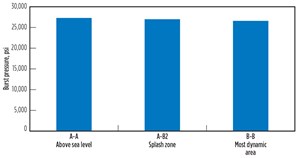
Indeed, compared with unexposed tubing subjected to artificial surface scratches, the tubing from the dynamic umbilical fared extremely well and, while showing a reduced timeline against the unexposed new material, remained well above the DNV design curve for stress.
CONCLUSIONS
Sandvik’s investigation of its tubing, deployed as part of the world’s first dynamic umbilicals, confirmed that seamless umbilical, super-duplex stainless steel tubing is a robust, reliable material for use in all the different umbilical functions, including control and chemical injection tubing.
No signs of corrosion or mechanical degradation were observed on either the internal or external surfaces of the tubes, and the mechanical properties of the stainless steel seamless tubing were at the same levels as when they were produced 19 years earlier.
Longitudinal scratches were found on the tube surfaces, which are believed to have originated from the retrieval and dissection of the tubing, and the poor surface condition of the tubes affected their performance during fatigue testing.
Increased hydrogen content was found in those parts of the tubing in contact with cathodic protection, but, importantly, this was well within acceptable standards, and no HISC cracking was observed. There was also no sign of UTH fatigue.
No difference in fatigue life was identified between samples from the most dynamic section of the umbilical and the splash zone, and while a reduced fatigue life was noted, compared to reference data for unused tubes of similar dimensions, there was still a significant margin of safety when compared to the DNV design curve.
The tubes displayed a normal microstructure and a typical duplex weld microstructure (a single pass weld with filler). Having conducted a thorough investigation of its tubing deployed in the dynamic umbilical, the company is confident that the robust nature of the tubes would have enabled them to withstand another 17 years of service, and possibly longer, as a solution to steel tubing in umbilicals.
JOHN TOKARUK is the head of the umbilical tubing division at Sandvik, and has been with the company for 20 years. Mr. Tokaruk joined Sandvik in Canada in 1996, where he started as a process engineer in charge of production improvements and implementation of the umbilical tubing manufacturing process. In 2001, he moved to the Czech Republic, where he became the technical marketing manager. He also held the role of oil and gas manager for the Asia-Pacific region within Sandvik before moving back to the Czech Republic to become the global product manager for umbilical tubing. Mr. Tokaruk holds a bachelor’s degree in materials and metallurgical engineering from Queen’s University in Kingston, Canada. ![]()

- Subsea technology- Corrosion monitoring: From failure to success (February 2024)
- Applying ultra-deep LWD resistivity technology successfully in a SAGD operation (May 2019)
- Adoption of wireless intelligent completions advances (May 2019)
- Majors double down as takeaway crunch eases (April 2019)
- What’s new in well logging and formation evaluation (April 2019)
- Qualification of a 20,000-psi subsea BOP: A collaborative approach (February 2019)

